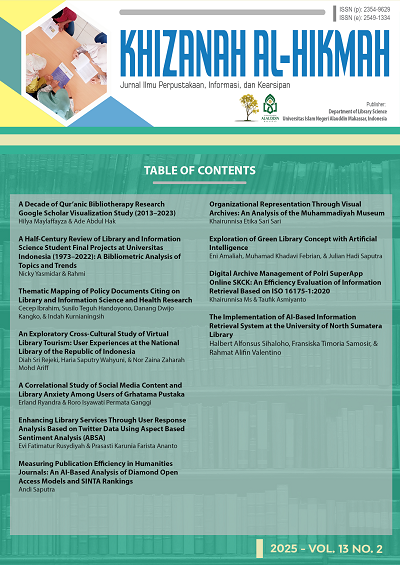Thematic Mapping of Policy Documents Citing on Library and Information Science and Health Research
DOI:
https://doi.org/10.24252/v13i2a3Keywords:
Bibliometric, Library and information science research, Health science research, Thematic mapping, Policy documentsAbstract
Research in Library and Information Science (LIS) and Health has substantial applicability, including its use as a reference in the development of policy documents. This study aims to conduct a thematic mapping of policy documents that draw upon LIS and Health research. Using the Latent Dirichlet Allocation (LDA) method and Python-based machine learning, the research followed stages of data collection, filtering, processing, and analysis. The findings show that the Journal of Health Communication is the most frequently cited journal, with 1,756 citations. The United States emerges as the country that most extensively incorporates LIS and Health research into policy documents, accounting for 1,181 citations. The Centers for Disease Control and Prevention (CDC) is identified as the institution producing the highest number of policy documents referencing LIS and Health research, with 840 publications. The peak year for such publications was 2019, with a total of 384 documents. Thematic mapping reveals five dominant topics in these policy documents: Health Prevention, Youth Health, Science Dissemination, Risk Evaluation, and Development Strategies. The study highlights that LIS and Health research plays not only an academic role but also serves as a normative and strategic foundation for national policy formulation. Future research may apply similar methods to other disciplinary domains or conduct longitudinal analyses to identify thematic developments in policy documents over time.
Downloads
References
Abroms, Lorien. c, Ahuja, M., Kodl, Y., Thaweethai, L., Sims, J., Winickoff, J. P., & Windsor, R. A. (2012). Text2Quit: Results From a Pilot Test of a Personalized, Interactive Mobile Health Smoking Cessation Program: Journal of Health Communication: Vol 17, No sup1. https://www.tandfonline.com/doi/abs/10.1080/10810730.2011.649159
Afraz, A., Chashmyazdan ,Mohammadreza, Khajouei ,Reza, & and Bagherinezhad, Z. (2025). Literature Searches in Medical Informatics Systematic Reviews: Suggested Approaches. Medical Reference Services Quarterly, 44(1), 17–30. https://doi.org/10.1080/02763869.2024.2429066
Aleixandre-Benavent, A. S.-C., A. Alonso-Arroyo, R. Lucas-Domínguez, J. González de Dios, R. (2019). Bibliometría e indicadores de actividad científica (XIV): Métricas alternativas o altmétricas. Nuevas formas de medir el impacto de la ciencia. Acta Pediátrica Española. https://www.actapediatrica.com/index.php/secciones/formacion-e-informacion-en-pediatria/1592-bibliometria-e-indicadores-de-actividad-cientifica-xiv-metricas-alternativas-o-altmetricas-nuevas-formas-de-medir-el-impacto-de-la-ciencia
Allweiss, T., Cook, T., & Wright, M. T. (2021). Wirkungen in der partizipativen Gesundheitsforschung: Eine Einordnung in die Diskurse zum Forschungsimpact. Bundesgesundheitsblatt - Gesundheitsforschung - Gesundheitsschutz, 64(2), 215–222. https://doi.org/10.1007/s00103-020-03268-8
Becker, D. (2025). Health Information Apps to Counter Misinformation, Disinformation, and Fake News. Journal of Electronic Resources in Medical Libraries, 0(0), 1–7. https://doi.org/10.1080/15424065.2025.2496617
Published
How to Cite
Issue
Section
License
Copyright (c) 2025 Cecep Ibrahim, Susilo Teguh Handoyono, Danang Dwijo Kangko, Indah Kurnianingsih

This work is licensed under a Creative Commons Attribution-NonCommercial-ShareAlike 4.0 International License.
By submitting your manuscript to our journal, you are following Copyright and License



